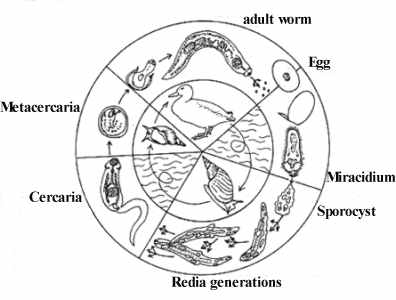
Lifecycle of Echinostoma spp. (HAAS et al., 1995)

Lifecycle of Echinostoma spp. (HAAS et al., 1995) |
We work presently with the cercariae of 4 Echinostome species, which we obtain from intermediate host snails Lymnaea stagnalis, collected in fish ponds near Höchstadt/Aisch (Echinostoma revolutum, Pseudechinoparyphium echinatum, Hypoderaeum conoideum and Isthmiophora melis) and miracidia of one Echinostome species living in Biomphalaria alexandrina (Echinostoma caproni). In the life cycle of these species, the aquatic snail (Lymnaea stagnalis bzw. Biomphalaria alexandrina) is invaded by the first larval stage, the miracidium. These snails serve as first intermediate hosts. The cercariae leaving in this snail search and invade other aquatic snails (not I. melis, invades frogs) as second intermediate hosts, where they encyst as metacercariae. The metacercariae develop to adult worms in the intestine of ducks, other birds or vertebrates when the second intermediate host is ingested. We study how echinostome cercariae find, recognize and invade the snails. Main results show, that the cercariae find the snail host employing orientation mechanisms and host cues as stimuli that differ considerably from those used by miracidia (Haberl et al.). The cercariae of H. conoideum swim chemotactically along increasing concentration gradients of small peptides of snail origin, which have been analysed. The cercariae of the other 2 species can not follow concentration gradients. They just turn back if the concentration of the snail attractant decreases. The attractants are amino acids and probably other amino compounds, which are presently determined.
We also analyse glycoconjugates that seem to be attractive for miracidia of E. caproni.
|
|
|||
Wilfried Haas, Bernhard Haberl, Tina Loy, Bernadett Beran, Jan Hertel